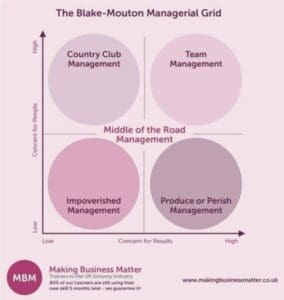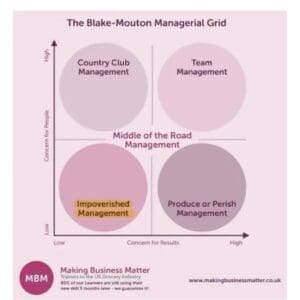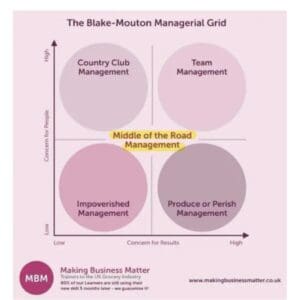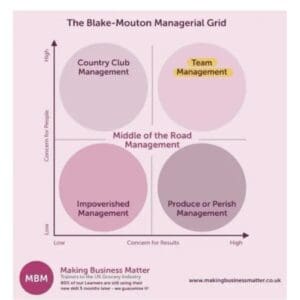Blake Mouton Grid: Finding the Balance for Success
Leadership isn’t just about being nice. And it’s not just about getting things done. It’s about balance. That’s what the Blake Mouton Grid tries to explain.
If you’ve never heard of it, don’t worry. It’s a simple tool that shows how leaders behave based on two things: how much they care about people and how much they care about tasks. Some focus only on the work. Others focus only on their team. A few manage to do both. But many don’t even realise where they stand or what it’s costing them.
This article isn’t about theory. It’s about real leaders, the ones we read about and work for. Some got it right. Others completely missed the mark. But all of them can teach us something.
By the end, you’ll know where you sit on the grid and, more importantly, how to shift into a better spot. One that helps your team grow, gets results, and doesn’t burn anyone out, including you.

1. Impoverished Management (Low People / Low Task)

Let’s start with the worst kind of leadership on the Blake Mouton Grid. It’s called Impoverished Management. That’s just a fancy way of saying: the leader doesn’t care about people or the work. They don’t support their team, and they don’t push for results.
It’s like having no leader at all. Decisions get delayed. Problems pile up. People don’t know what’s going on or what they should do. Teams get lost, frustrated, or just stop caring.
Sometimes, leaders don’t mean to end up here. Maybe they’re burned out. Maybe they avoid conflict. Or maybe they just care more about looking good than doing good.
A real-world example? Elizabeth Holmes, the founder of Theranos. She had a big vision. But she ignored experts, faked progress, and avoided tough conversations. She acted like everything was fine while the science and the team were falling apart. That’s classic Impoverished Management in the Blake Mouton Grid: all image, no substance.
Elizabeth Holmes at Theranos
Now, you might be thinking: Wait, wasn’t Holmes super ambitious?
Yes. But ambition doesn’t equal leadership. Under the surface, Theranos was the perfect storm of impoverished leadership in the Blake Mouton Grid. Here’s why:
-
Zero transparency: Employees weren’t allowed to ask questions or voice concerns. Those who tried? They were fired, sued, or “disappeared” from the company culture entirely.
-
No accountability: The board, made up of big names like Henry Kissinger and Jim Mattis, had zero experience in biotech and didn’t challenge Holmes even when whistleblowers spoke up.
-
No care for people: Employees worked in a toxic, paranoid environment. Their concerns about safety and accuracy were shut down. This wasn’t just a business failure, it put people’s health at risk.
Holmes retained 99% of the company’s voting rights and actively dodged oversight. She created a “make-believe” board of high-profile names and used celebrity images to mask the lack of real progress
It’s no surprise the result was catastrophic:
- $945 million in investor losses.
- False test results that put patients in danger.
- And finally, a 2022 conviction for fraud.

Why This Happens More Than You Think
This kind of leadership often creeps in when:
-
Founders are idolised instead of challenged.
-
Teams are silenced instead of heard.
-
Boards or senior managers lack the skills or courage to demand accountability.
Theranos’ leadership clearly demonstrated the pitfalls of Impoverished Management in the Blake Mouton Grid: no focus on people, no focus on tasks, and no vision for the future.
Sticky Learning ® is 7 times more effective than 1-day training courses. Plus, you will get a Chain of Evidence proving your Return on Investment. Discover soft skills training that changes behaviours long term.

How to Fix It — And Apply It
Here’s the part that matters: how to spot and fix this type of leadership in real life. Whether you’re a CEO, a manager, or just someone who cares about doing better, these are real, fresh solutions:
1. Build a feedback culture that works
In an impoverished leadership environment, communication is often broken. Employees are afraid to speak up, or they feel ignored when they do. To fix this, build a feedback culture that allows employees to give real-time input on decisions, projects, and leadership styles.
Platforms like Officevibe or 15Five make it easier to collect feedback quickly. These tools give employees a chance to share their thoughts, opinions, and ideas on what’s working and what needs improvement. For example, Atlassian, known for its collaboration tools, uses Team Health Checks to get weekly feedback from employees. This helps them spot problems early and make improvements before issues grow too large.
2. Train your board or senior team to challenge you
Impoverished leadership often happens when leaders surround themselves with people who only agree with them. This leads to bad decisions and a lack of growth. Great leaders know they need a diverse range of voices to thrive. To prevent a “yes-man” culture, leaders must be open to disagreement and embrace challenges.
At Netflix, CEO Reed Hastings encourages healthy conflict in decision-making. He believes that in order to grow and innovate, leaders and employees must challenge each other’s ideas. By encouraging different viewpoints, Netflix could take risks and change the way people watch TV, making them the giant they are today.
If you want to fix impoverished leadership, you need to surround yourself with people who will push back. Leaders should actively seek out differing opinions to make better decisions and ensure they’re staying ahead of the curve.
Tip: Ask your board members, “What do I not want to hear right now?” and force open that space.
3. Separate your ego from your product
Impoverished leaders often focus more on their public image than the work being done. This is a problem. The most successful leaders don’t care about being the face of the company. They focus on creating real value and results for their team and customers.
Take Dee Hock, the founder of Visa. Unlike many leaders who chase fame, Hock prioritised substance over style. He revolutionised the credit card industry by creating a decentralised system that empowered member banks to collaborate rather than compete. His focus was on building a robust and sustainable organisation, not on personal recognition. Under his leadership, Visa grew into one of the most successful corporations in the world, with a trillion-dollar valuation by 1996.
Leaders should stop worrying about publicity and start focusing on building long-term value. This leads to trust, respect, and real growth.
“If you build a great business, celebrity will find you. It shouldn’t be your focus from the start.” — Professor Lester Alexander, UVA Darden
4. Watch your culture like a hawk
Toxic cultures aren’t always loud. Sometimes, they’re subtle. One person being silenced, one bad meeting dynamic, one little lie. Impoverished leadership can happen when teams avoid tough conversations, thinking they’ll fix issues later. But waiting only makes things worse. The key is to encourage honest and open communication. Leaders must be willing to receive direct feedback and act on it.
The concept of Radical Candor, developed by Kim Scott, teaches that leaders should care personally but challenge directly. At Bridgewater Associates, employees are encouraged to argue for the sake of truth. This approach creates a culture where hard truths are faced, and the company is constantly improving. When leaders create a safe environment for honest discussions, it leads to more trust and stronger decision-making.
Creating a culture of radical candor helps prevent problems from getting worse. Leaders must encourage their teams to speak freely and be brave enough to address difficult issues head-on.
It adds up. A 2022 MIT Sloan study found that toxic culture is 10.4x more powerful than compensation in predicting employee attrition.
2- Country Club Management (High People / Low Task)

In Country Club Management of the Black Muton Grid, leaders prioritise relationships and employee happiness over work goals or task completion. The idea is to create a relaxed, enjoyable work environment where employees are treated like family, with lots of perks and attention to their well-being. While this approach helps create strong bonds and a positive culture, it can also lead to a lack of accountability and a focus on fun rather than productivity.
A Country Club Manager, according to the Blake Mouton Grid, avoids making tough decisions, especially when it comes to performance issues or conflict.They might offer employees all sorts of perks such as flexible schedules, wellness programs, and recreational spaces but without a strong focus on achieving business objectives. Over time, this can result in low productivity, missed deadlines, and unproductive work habits.
Adam Neumann at WeWork
Adam Neumann, the co-founder of WeWork, was a classic example of a Country Club Manager, as described by the Blake Mouton Grid. He famously offered employees free snacks, fancy office spaces, and an energetic, hip work culture that encouraged creativity and collaboration. However, behind this culture, WeWork struggled with financial mismanagement, inconsistent operations, and a lack of clear strategy.
Neumann’s leadership created an atmosphere where the company’s culture was overly hyped and employee-focused, but the actual performance metrics and business execution were weak. As a result, WeWork’s highly publicised IPO attempt in 2019 came crashing down, with investors pulling back due to the company’s unprofitability and questionable governance. While many employees loved working at WeWork, the company ultimately couldn’t sustain its ambitious vision without a solid operational backbone. This is a perfect example of how the Country Club Management style from the Blake Mouton Grid can lead to significant business challenges.
How to Fix Country Club Management
To move away from Country Club Management, where fun takes priority over work, leaders need a plan that mixes people care with business results. Here’s how to make it happen in a way that’s fresh and different:
1- Create a “Culture of Growth”
Instead of just focusing on perks or fun activities, build a culture where growth is celebrated. Encourage employees to learn new skills, try new projects, and get feedback. When employees see their growth as part of the company’s mission, they are more likely to take ownership of their tasks. This reflects the ideal leadership style in the Blake Mouton Grid, where leaders are equally invested in developing people and hitting performance targets.
For example, LinkedIn has created a “culture of learning” where employees are encouraged to pursue courses and receive feedback. This way, LinkedIn combines personal development with business goals. When people grow, so does the company.
2- Set Clear, Shared Goals
According to the Blake Mouton Grid, one of the biggest pitfalls of Country Club Management is low task orientation. Instead of just setting KPIs for individuals, create shared goals that everyone in the company can work toward together. Make sure employees understand that while their happiness matters, their success also drives the company’s performance. By creating a unified team vision, everyone becomes responsible for results, not just enjoying perks.
Spotify did this by making its teams responsible for specific projects that tie directly into larger company goals. Each team gets the freedom to be creative but is also measured by how their project affects overall business outcomes.

3- Celebrate Wins and Challenge Employees
Yes, celebrate when things go well, but also challenge employees when things aren’t working. The Blake Mouton Grid reminds us that effective leaders don’t avoid hard conversations. However, to drive change, leaders should not only reward employees for reaching goals but also guide them through challenges. Sometimes, those hard conversations can help employees see what they need to improve.
For example, General Electric (GE) under Jack Welch didn’t shy away from hard conversations. He celebrated the company’s wins but also encouraged tough feedback and challenged employees to improve constantly. This kept the company innovative and results-driven while still valuing people.
4- Mix Flexibility with Structure
Flexibility and a positive work culture are important, but so is structure. Employees need to understand that flexibility comes with responsibility. Giving employees freedom is great, but without clear boundaries and expectations, it can be hard to measure success. Leaders should create clear structures, like regular check-ins or team reviews, to keep track of goals.
Slack is a great example. The company offers a relaxed, flexible work environment, but it also makes sure that all employees are aligned with company objectives. Through team meetings and collaborative goals, Slack ensures both flexibility and accountability go hand-in-hand.
5- Link Perks to Results
Finally, avoid perks for perks’ sake. As shown in the Blake Mouton Grid, leaders who focus only on relationships risk undermining performance. Whether it’s a bonus, extra vacation days, or special recognition, making sure perks are tied to performance helps keep everyone focused on what matters: delivering results.
Netflix does this by offering employees freedom (like unlimited time off) but linking that freedom to high performance. If someone isn’t meeting performance goals, they are held accountable, even if they have access to the same perks. This balance keeps employees engaged without losing sight of business goals.
4- Middle-of-the-Road Management (Medium Task / Medium People)

Middle-of-the-Road Management on the Blake Mouton Grid refers to a leadership style that balances task-oriented and people-oriented approaches. Managers in this style focus on getting work done while maintaining decent relationships with employees. They’re not too strict with the task side, but they’re also not overly nurturing. They strike a middle ground ensuring that both people’s needs and the business objectives are met, but without pushing either one too hard.
Tim Cook – Apple Post-Steve Jobs (Early Years)
Tim Cook became CEO of Apple after Steve Jobs passed away in 2011. It was a huge challenge because Jobs was such an important figure. In the beginning, Cook was seen as steady and calm, bringing balance to a company that had been driven by Jobs’ bold energy. But some people felt Cook’s leadership was “too safe,” and that Apple wasn’t innovating as much. The company was still successful, but it became more predictable.
Cook focused on stability and kept Apple’s existing products running smoothly. Under his leadership, Apple released new versions of the iPhone and iPad, keeping its strong position in design and tech. But, compared to Jobs’s time, many felt Apple was not as groundbreaking. Cook was good at managing the business, but he didn’t take as many risks or push boundaries as Jobs did.
One well-known example is the Apple Watch, which didn’t change the world like the iPhone did. Some analysts believed Cook was too careful, and Apple wasn’t as disruptive as it used to be. His time in Cook’s leadership shows what’s called a “Middle-of-the-Road” management style in the Blake Mouton Grid, balancing people and tasks but not taking bold actions.
How to Fix It: Push for Boldness
To fix Middle-of-the-Road Management, leaders need to get out of their comfort zone and embrace bolder actions. Here’s how to do that:
1- Encourage Bold Ideas and Risk-Taking
To prevent stagnation, it’s crucial to push for new ideas that are out of the ordinary. Leaders should encourage innovative thinking. To escape the mediocrity of Middle-of-the-Road Management on the Blake Mouton Grid, leaders need to stop playing it safe and encourage calculated risk-taking. Don’t always play it safe; sometimes, it’s the bold moves that set companies apart. Leaders can ask, “What’s the worst that can happen if we try this new idea?” instead of, “What’s the safest choice?”
For instance, Google X, known for developing self-driving cars and other moonshot projects, encourages thinking big. They aim for breakthroughs that might seem impossible, and this has resulted in ground-breaking technologies. Similarly, Tim Cook could have driven Apple toward more daring innovations if he had introduced this culture of risk-taking earlier. Apple might have been known for revolutionary products much sooner.
2- Hold Monthly “Moonshot” Brainstorms
If you want creativity to flow, hold regular brainstorming sessions where all ideas are welcome. No idea is too crazy or too small. Create a safe space where people feel comfortable sharing new concepts without judgment.
SpaceX, under Elon Musk, thrives on these brainstorming sessions, where engineers pitch the most outlandish ideas. Not all ideas are pursued, but they fuel the company’s creative spark.
Tim Cook could have created a similar space at Apple by holding regular sessions to discuss not just the next iPhone but also ideas that could completely change the game. Even in the tech world, sometimes the best ideas come from a mix of structure and imagination.
3- Challenge Your Team to Step Out of Their Comfort Zones
A major downside of Middle-of-the-Road Management, as outlined in the Blake Mouton Grid, is the tendency to maintain harmony at the expense of ambition. This can lead to stagnation. When everything is a balanced, it can lead to a lack of urgency and creativity. To fix this, set stretch goals that push people beyond what they’re used to.
Nike is a prime example here. Under Phil Knight, Nike pushed boundaries in sportswear and marketing by trying new concepts, even when they weren’t sure they would work. This willingness to try bold ideas (like the Just Do It campaign) set them apart from their competitors. Leaders in Middle-of-the-Road Management can do this too by setting bigger, visionary goals that encourage the team to innovate, even if the risk is high.
4- Create a Culture That Celebrates Failure
In a Middle-of-the-Road system, failure might be seen as something negative. But to innovate, you need to embrace failure as a part of the learning process. Teach your team that it’s okay to fail as long as you learn and bounce back stronger.
Amazon thrives in this area, as Jeff Bezos encourages experimentation even if it fails. The Fire Phone was a huge flop, but Bezos took it in stride, learning from the mistakes and channeling that experience into more successful innovations like Alexa.
Leaders should build a culture where failing is seen as a stepping stone to success, not as a setback. If your team feels safe to experiment and fail, they’ll likely be more creative and innovative.
5. Team Management (High Task / High People)

In the High Task / High People quadrant of the Blake Mouton Grid, managers prioritise both high performance and strong relationships. This leadership style focuses on balancing the demands of getting results with the importance of supporting and motivating people. Leaders here are not just focused on output—they are equally invested in the well-being, development, and collaboration of their teams.
This style is often considered the ideal because it leads to productive, engaged teams that deliver outstanding results while also maintaining a positive, inclusive culture. The leader pushes their team to achieve high goals while also ensuring that team members feel supported, respected, and empowered to grow.
Satya Nadella – Microsoft
When Satya Nadella became CEO of Microsoft in 2014, the company was struggling. Although there were many talented employees, the culture felt disconnected, and innovation had slowed down. Nadella quickly saw that Microsoft needed to change both its culture and its business approach to succeed again.
He introduced a growth mindset, encouraging employees to embrace challenges and see failures as chances to learn, not as losses. He also worked to break down the barriers between different departments, making it easier for people to work together. Nadella stressed that working together toward shared goals was the key to success, rather than focusing only on individual achievements.
Because of these changes, Microsoft’s culture improved, and the company saw a big increase in innovation and profits. Nadella’s leadership in the High Task / High People quadrant of the Blake Mouton Grid didn’t just focus on driving results; he ensured employees had the tools, support, and respect they needed to succeed, leading to greater engagement and overall performance.

How to Implement It
To improve your leadership style and take your team to the next level, follow Nadella’s example by combining strong leadership with empathy, as guided by the Blake Mouton Grid.
1- Shift from “Boss” to “Coach”
In the Blake Mouton Grid, managers who only focus on tasks (Authority-Compliance style) may get short-term results but risk burning out their team. Instead of just giving orders, try being a coach who helps your team learn and grow. You can host regular “coaching circles” where you share tips, talk about challenges, and work together to find solutions. At companies like Google, managers often hold informal coaching sessions. These are not just about project updates but also about personal growth and development goals. This helps create a strong sense of partnership and lets managers connect with their teams on a deeper level. It shows that managers care about both work and personal growth, helping everyone feel more supported.
2- Celebrate Micro-Wins
In high-performance environments, it’s easy to focus only on big wins. But to keep teams motivated and feeling appreciated, it’s important to celebrate small victories too. Celebrating these wins helps balance task completion and people satisfaction, a principle central to the Blake Mouton Grid. For example, at Zappos, employees are recognised for anything from helping a customer to trying a new process that works. They use micro-recognition moments to celebrate positive behavior regularly. By doing this, they make every success count, which helps keep the team engaged and maintain momentum. This culture of constant acknowledgment makes everyone feel valued, boosting overall team spirit and performance.
3- Create a “Collaboration Lab”
Moving toward a Team Leadership style on the Blake Mouton Grid means breaking silos and encouraging collaboration across departments. To encourage more cross-team collaboration, create a “collaboration lab” where employees from different departments can come together to brainstorm, test ideas, and prototype new projects. For instance, at Pixar, employees from different disciplines (like animators, engineers, and writers) are encouraged to share ideas openly in collaborative spaces. This breaks down barriers and sparks creativity and problem-solving.
4- Use Data to Personalise Development
Use data to tailor development opportunities to each employee. For example, at LinkedIn, managers have access to data on employee performance and growth areas, allowing them to provide personalised coaching. This way, employees receive the support they need based on their challenges and goals instead of a one-size-fits-all approach. Tracking data on employee progress can also help you identify and celebrate improvements and areas for growth.
Conclusion
In conclusion, the Blake Mouton Grid can help leaders become better at balancing both people and tasks. Every leader, whether task-focused or people-focused, can improve their style. By looking at leaders like Satya Nadella, Tim Cook, and Adam Neumann, we can learn from their successes and mistakes. The key is to adapt your leadership style to fit your team’s needs. When you balance the right mindset with the right actions, you can help both your team and your company succeed. With the right approach, any leader can make a big difference in their organisation.




